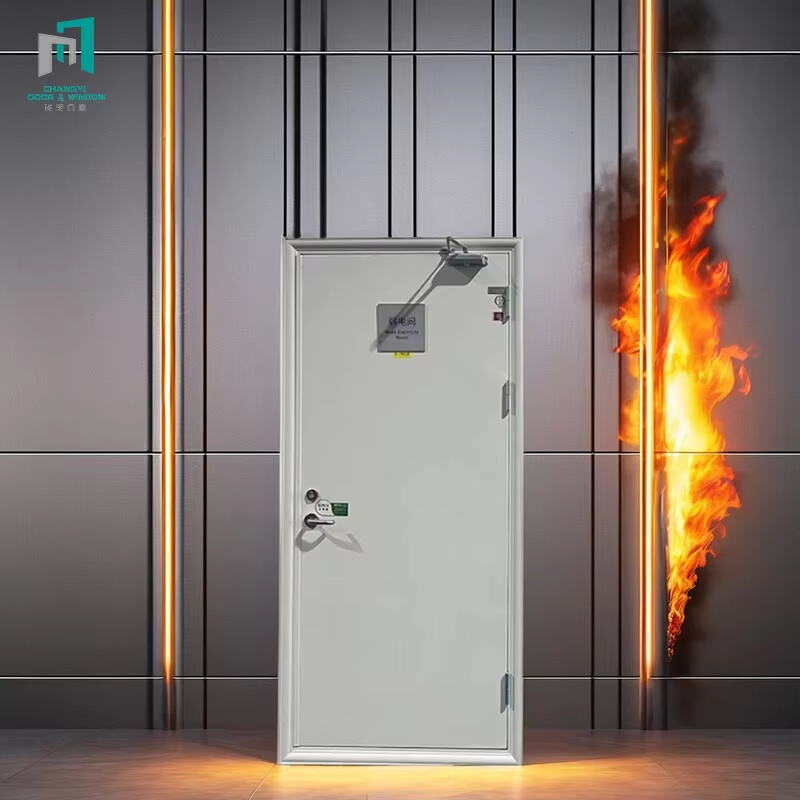Bevezetés: Röviden magyarázza el a tűzellenőrző ajtok jelentőségét az épületbiztonság és a jogszabályoknak való megfelelés szempontjából.
A tűzgátló ajtók nagyon fontos szerepet játszanak az épületek tűzbiztonságában. Alapvetően falakként működnek a lángok és a füst ellen, megakadályozva, hogy a tűz tovaterjedjen az épületben. Ez értékes perceket biztosít az ott tartózkodók számára a menekülésre, mielőtt a helyzet túl veszélyessé válna. Bár ezek az ajtók segítenek az épület károsodásának megelőzésében, fő céljuk valójában az életmentés vészhelyzetekben. Megfelelő telepítés esetén a tűzgátló ajtók különálló szakaszokat hoznak létre az épületben, így a tűz nem terjedhet át gyorsan a szobákból. Ez a lezárás segít korlátozni a károkat, és időt ad a tűzoltóknak, hogy elérjék az érintett területeket, és eloltják a lángokat, mielőtt teljesen kormányozhatatlanná válnának.
A tűzgátló ajtók rendkívül fontosak a tűzvédelmi előírások és építési szabályok betartása szempontjából. A legtöbb helyen jogszabály írja elő a használatukat, ami hozzájárul az épületek biztonságához, és védi az ingatlantulajdonosokat attól, hogy baj esetén problémába kerüljenek. Az épületüzemeltetőknek rendszeresen ellenőrizniük is kell a tűzgátló ajtókat. Ha már nem működnek megfelelően, egyszerűen nem lesznek képesek hatékonyan megakadályozni a tűz terjedését. Egyes helyi hatóságok pénzbüntetést is kiszabnak az ilyen területek elhanyagolásáért. Ezért az ellenőrzések rendszeres elvégzése jogi és gyakorlati szempontból is ésszerű. Amikor az üzemeltetők betartják ezeket az előírásokat, nem csupán papíron teljesítik a követelményeket, hanem valós védelmet biztosítanak azoknak a személyeknek, akik az épületben élnek vagy dolgoznak, a potenciális tűzveszélyekkel szemben.
Mi a tűzajtók?
A tűzgátló ajtókat kifejezetten arra tervezték, hogy ellenálljanak a lángoknak, és megakadályozzák azok terjedését az épületekben. Fő feladatuk? A tűz és a füst beazonosítása bizonyos területeken, hogy az egész szerkezet épen maradjon, és a bent lévő emberek biztonságban legyenek. Ezek az ajtók jelentős szerepet játszanak a passzív tűzvédelmi rendszerekben, olyan akadályként működve, amelyek a tüzeket az eredeti helyükön tartják, és megakadályozzák, hogy átterjedjenek más szobákba vagy emeletekre. Amikor megfelelően be vannak szerelve és rendszeresen ellenőrzik őket, ezek az ajtók megbízható tűzálló falakat képeznek, ami kritikus fontosságú lehet vészhelyzetekben, ahol minden másodperc számít a mentési és károkozási tevékenységek során.
Amikor tűzálló ajtókról van szó, több fontos jellemzőt is érdemes figyelembe venni. Először is, a tűzállósági osztályozás nagyon fontos, mivel ez határozza meg, hogy az ajtó mennyi ideig képes ellenállni a lángoknak, mielőtt megsérülne. A szabványos ajtók osztályozása általában 30 perc és 90 perc között mozog, de akár ennél hosszabb is lehet bizonyos esetekben. Egy másik lényeges elem a saját magát becsukó mechanizmus. Ezek az eszközök biztosítják, hogy az ajtó automatikusan becsukódjon, amikor a füstérzékelők jeleznek a tűzriadó idején. Ezek nélkül a lángok és a füst sokkal gyorsabban terjedhetnének a épület folyosóin, mint azt tervezték. Az ajtók ténylegesen használt szerkezeti anyagai is nagyban befolyásolják hatékonyságukat. Az acél továbbra is az egyik leggyakoribb választás, annak szilárdsága és hőállósága miatt. A gipszkarton és a vermiculit kompozitok is másik népszerű alternatíva. Mindezen anyagok együttesen hozzák létre azokat a határokat, amelyek megakadályozzák, hogy veszélyes hőmérséklet érje el az épület más részeit, miközben értékes időt biztosítanak az embereknek a biztonságos meneküléshez.
A tűzálló ajtók szakszerű beszerelése nagyon fontos ahhoz, hogy a legkritikusabb pillanatokban, tűz esetén megfelelően működjenek. Amikor szakemberek végzik a munkát, pontosan tudják, hogyan kell minden alkatrészt beépíteni, hogy az ajtó valóban megakadályozza a lángok terjedését a tűz kezdetét követően. Kérdezze meg csak bármely épületkezelőt, aki problémába ütközött, mert valaki sietve, nem szakszerűen végezte a beszerelést. Ezek az ajtók nem csupán dísznek vannak; alapvető fontosságúak ahhoz, hogy minden tűzbiztonsági előírásnak megfeleljenek. A helyi előírások amúgy is előírják a szabályos beszerelést, de a szabályokon túl is, a megfelelően beszerelt tűzálló ajtók valóban életeket menthetnek, mivel biztonságos menekülési útvonalakat biztosítanak éppen akkor, amikor a legnagyobb szükség van rájuk. Az épületüzemeltetőknek érdemes alaposan átgondolni, hogy ezen a téren megtakarításokat végezzenek, mivel a rossz beszerelés egy egyébként kiváló tűzálló ajtót semmivé változtathat, csupán drága díszként funkcionálva.
A Tűzajtók Szerepe a Biztonságban
A tűzgátló ajtók nagyon fontosak a passzív tűzvédelem szempontjából, mert segítenek megakadályozni a füst és lángok terjedését az épületen belül. Ezek az ajtók a kompartmentálási stratégia részét képezik. Alapvetően ez a megközelítés arra törekszik, hogy a tüzet helyben tartsa, és megakadályozza, hogy az az épület más területeit is érintse. Ha a tűzgátló ajtók megfelelően működnek, akkor értékes plusz időt biztosítanak az épületben tartózkodók számára a biztonságos meneküléshez, valamint nagyobb esélyt adnak a tűzoltók számára, hogy elérjék a helyszínt. Az időnyerés különösen fontos, mivel lehetővé teszi a mentőszolgálatok gyors reagálását, mielőtt a helyzet súlyosabbá válna, végül is csökkentve az emberekre és az épületekre egyaránt fenyegető veszélyt.
Tűzoltás statisztikák szerint valóban hatékonyan csökkentik a halálozásokat, amikor tűz üt ki. A tűzvédelmi szervezetek szerint, ha ezeket az ajtókat megfelelően telepítik és jó állapotban tartják őket, akkor a tűz káros hatásait körülbelül felére csökkenthetik. Miért élnek túl többen? A tűzálló ajtók megakadályozzák, hogy a veszélyes füst és lángok túl gyorsan terjedjenek. Megőrzik a menekülési útvonalakat hosszabb ideig, így az épületben tartózkodóknak több idejük van elmenekülni, mielőtt a helyzet túl veszélyessé válna. Ezért rendkívül fontos a tűzálló ajtók rendszeres ellenőrzése és az, hogy minden biztonsági előírásnak megfeleljenek, hiszen ezek mentik az életeket vészhelyzetekben.
A tűzgátló ajtók rendkívül fontos szerepet töltenek be az emberek biztonságának megőrzésében, amikor épületekben tűz keletkezik. Ezek az ajtók a legtöbb kereskedelmi térben megtalálható kijáratok mentén helyezkednek el, és rendszeresen ellenőrizni kell őket, hogy szükség esetén megfelelően működjenek. Ezek az ajtók valójában világos menekülési útvonalakat biztosítanak az égő épületekből, ami vészhelyzetben életet menthet. Nagyon fontos, hogy szakértők helyezzék el őket megfelelően, valamint az is, hogy az idők során karbantartsák azokat. Ha minden rendben működik, az épületben tartózkodóknak nagyobb az esélye a biztonságos menekülésre, és a vagyoni károk is kezelhetőbb mértékűek maradnak.
Szabályozások és megfelelőség
A tűzgátló ajtókra vonatkozó építési előírások nagyon fontosak az emberek biztonsága és a jogszabályok betartása szempontjából. Szervezetek, mint például a Nemzeti Tűzvédelmi Társaság (National Fire Protection Association) fontos szabályokat határoznak meg dokumentumokon, például a NFPA 80-on keresztül. Ez az irányelv pontosan meghatározza, hogyan kell telepíteni és karbantartani a tűzgátló ajtókat, hogy valóban működjenek vészhelyzet esetén. A helyi hatóságoknak is megvannak a saját építési előírásaik, amelyek attól függenek, hogy hol élünk. Ezek a helyi szabályok különböző régiókban fennálló kockázatokat és épületstílusokat is figyelembe vesznek. Mindezen szabványok lényege az, hogy megakadályozzák a tűz terjedését, és biztosítsák, hogy a tűzgátló ajtók hatékonyan elzárják a veszélyes füstöt és hőt incidensek alatt. Ha minden a tervek szerint működik, akkor az épületben tartózkodóknak értékes plusz időt biztosítanak a biztonságos meneküléshez.
Az emberek arra bírása, hogy kövessék ezeket a szabályokat, valójában a hatékony ellenőrzési rendszerek meglététől függ. Amikor a gyártók tanúsítványokat kapnak olyan helyektől, mint az Underwriters Laboratories (UL), ez lényegében azt jelenti, hogy tűzálló ajtóik átestek bizonyos biztonsági követelményeket meghatározó teszteken. Akik ezt az egészet ellenőrzik? Tűzoltó felügyelők. Sok időt töltenek azzal, hogy tűzálló ajtókat vizsgálnak körútjaik során, és meggyőződnek arról, hogy minden tényleg a szabályoknak megfelelően működik. Pontosan mit keresnek? Hát, először megvizsgálják, hogy az ajtó tömítése mennyire ellenálló a hővel és füsttel szemben. Aztán ott van a záródó mechanizmus kérdése – megfelelő módon becsukódik szükség esetén? És végül összevetik ezeket a fizikai ellenőrzéseket a hivatalos tanúsítványokkal, hogy megerősítsék: semmi sem került el vagy félreértelmezésre.
Amikor az épületek nem tartják be a tűzvédelmi ajtókra vonatkozó szabályokat, a következmények meglehetősen súlyosak lehetnek. Az ingatlantulajdonosok jelentős bírságokat kaphatnak, vagy jogi problémába ütközhetnek, különösen akkor, ha egy tűz esetén károk keletkeznek, vagy valaki megsérül a hibás ajtók miatt. A valódi veszély az jelenti, ami a valós vészhelyzetek során történhet. A nem megfelelő ajtók lényegében mindenkit nagyobb kockázatnak tesznek ki. Ezek az ajtók akadályozhatják a menekülési utakat épp akkor, amikor a legnagyobb szükség lenne rájuk, vagy ami még rosszabb, lehetővé tehetik a füst és a lángok gyorsabb terjedését az épületben, ahelyett, hogy megfelelően elszigetelnék azokat. Ez nem csupán papírmunka kérdése, hanem arról szól, hogy életet mentsenek akkor, amikor minden másodperc számít.
Karbantartás és ellenőrzés
Fontos, hogy a tűzgátló ajtókat rendszeres karbantartással jó működő állapotban tartsuk, hiszen ez biztonsági szempontból kiemelkedően fontos. Rendszeres ellenőrzéssel időben észrevehetők a kisebb problémák, mielőtt komolyabb vészhelyzetté válhatnának. Az idő során különböző problémák léphetnek fel az ajtóknál – néha megvetemedhetnek, megsérülhetnek, vagy a szerelvények működése romolhat. A gumitömítések és más alkatrészek pedig természetes módon kopnak. A szakértők általában azt javasolják, hogy évente legalább egyszer hívjunk szakembert a tűzgátló ajtók ellenőrzésére. Ez ésszerű megoldás, mivel ezek a szakértők pontosan tudják, mit kell ellenőrizni, és el tudnak végezni minden szükséges javítást. A tűzgátló ajtóknak akkor kell megfelelően működniük, amikor a legnagyobb a szükség rájuk, ezért a karbantartás nemcsak ajánlott, hanem elengedhetetlen minden olyan személy számára, aki a épület biztonságáért felelős.
A tűzálló ajtók gyakran problémába ütköznek, például elgörbülhetnek, megsérülhetnek, vagy olyan szerelvényekkel rendelkezhetnek, amelyek nem működnek megfelelően. Amikor egy ajtó elkezd elgörbülni, megszakad a tömítés, amely a füsttől és lángoktól véd, ami nyilvánvalóan veszélyes. A megsérült alkatrészek esetleg nem bírják a terhelést, ha ténylegesen tűz keletkezik. A szerelvényekkel kapcsolatos problémák szintén gyakoriak – gondoljunk például olyan ajtókra, amelyek nem zárnak megfelelően, mert a zsanérok eltörtek, vagy az automatikus zárómechanizmus már nem működik. Ezek a kis részletek pedig nagyon fontosak. Ezekre a problémákra rendszeres ellenőrzéseket végezni nemcsak jó gyakorlat, hanem szükségszerű, hogy megakadályozzák a meghibásodásokat éppen akkor, amikor a legfontosabb lenne, és biztosítsák az épületeknek a mindenki számára szükséges tűzvédelmi előírásokkal való megfelelését.
A szakemberek általában azt javasolják, hogy évente legalább egyszer rendszeresen ellenőriztessük a tűzálló ajtókat képesített technikusokkal. Ezek során a szakemberek általában megvizsgálják, hogy az ajtó mennyire ellenálló általában, ellenőrzik, hogy megfelelően becsukódik-e magától, és észreveszik a fontos alkatrészek, mint például a zsanérok és reteszek esetleges sérüléseit. Az ilyen karbantartás időben észleli a problémákat, így azok ne okozhassanak később komoly költségeket. Emellett az is jelenti, hogy az ajtók hosszabb ideig elviselik a cserét. A tűzbiztonság nem valami, amivel kockázatot szabad vállalni, ezért ezekhez az alapvető szabályokhoz tartva magunkat biztosítjuk, hogy az ajtók valóban működjenek, amikor életet mentenek vészhelyzetekben.
Általánosságban vett, a megfelelő karbantartás és ellenőrzések nem csak a betartás miatt szükségesek, hanem alapvetően fontosak a tűzvédelmi integritás szempontjából. Az expert ajánlott ellenőrzési gyakoriságok betartásával és a gyakori problémák gyors megoldásával a épületek biztosíthatják, hogy a tűzapajtóik optimálisan működnek, így biztonságot és bizalomérzetet nyújtva.
Következtetés: Hangsúlyozza a tűzapajtók jelentőségét az épület általános biztonságának tekintetében
A tűzgátló ajtók nagyon fontosak az épületbiztonság szempontjából, mert megakadályozzák a tűz és a füst terjedését. Megfelelő telepítés esetén ezek az ajtók többletperceket biztosítanak az emberek számára, hogy elmenekülhessenek egy égő épületből, ezért elengedhetetlen részei bármely tűzbiztonsági stratégia alkotóelemei. Az ingatlankérelőknek naprakészen kell követniük a tűzvédelmi előírásokat, és biztosítaniuk kell, hogy az épületeikben lévő összes tűzgátló ajtó megfelelően működjön. Rendszeres ellenőrzések és jó karbantartási rutinfeladatok elvégzése biztosítani fogják, hogy ezek a biztonsági funkciók akkor is működjenek, amikor a legfontosabb.
A rendszeres képzés és a vészhelyzeti eljárásokkal kapcsolatos tudatosság nagyon fontos mindenki számára, aki épületekben dolgozik vagy azokat látogatja. Amikor az emberek tudják, hogyan kell megfelelően használni a tűzgátló ajtókat, és mit kell tenni, ha tűz keletkezik, az egész hely biztonságosabbá válik, és mindenki hatékonyabban tud reagálni valódi vészhelyzetek során. Az épületkezelőknek valóban figyelniük kell arra, hogy a tűzgátló ajtók megfelelő állapotban legyenek, és hogy a személyzet megfelelő képzést kapjon. Már túl sok olyan helyzetet láttunk, ahol az egyszerű tudás jelenthetett volna minden különbséget. A tűzriadók nem csupán egy lista lejegyzett pontjai, hanem életmentő gyakorlatok, amelyeknek minden érintett számára második természetükké kell válniuk.
GYIK
Miért fontosak a tűzkijáratak az épületbiztonságban?
A tűzkijáratak kulcsfontosságúak, mivel megakadályozzák a tűz és a dúsító gáz terjedését az épületen belül, több időt adva az épület lakói számára, hogy biztonságosan menekülhessenek, valamint segítenek a tűvészelyek korlátozásában.
Mik a tűzkijárat fő komponensei?
A fő komponensek közé tartoznak a tűzellenálló minőségértékek, az önbezáró mechanizmusok és a tűzellenálló anyagok, például a vas és a gipsz.
Milyen gyakran kell ellenőrizni a tűzkijáratakat?
A tűzajtókat évente tanúsított szakembereknek kell ellenőrizniük, hogy biztosan kiváló működési állapotban maradjanak.
Mi a nem megfelelés tűzajtó-követelményeknek vonatkozó következményei?
A nem megfelelés jogi büntetéseket, növekvő tűzveszélyt és a lakosok biztonságának kompromittálását eredményezheti.
Tartalomjegyzék
- Bevezetés: Röviden magyarázza el a tűzellenőrző ajtok jelentőségét az épületbiztonság és a jogszabályoknak való megfelelés szempontjából.
- Mi a tűzajtók?
- A Tűzajtók Szerepe a Biztonságban
- Szabályozások és megfelelőség
- Karbantartás és ellenőrzés
- Következtetés: Hangsúlyozza a tűzapajtók jelentőségét az épület általános biztonságának tekintetében
- GYIK

